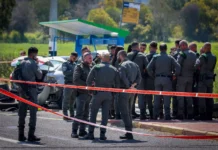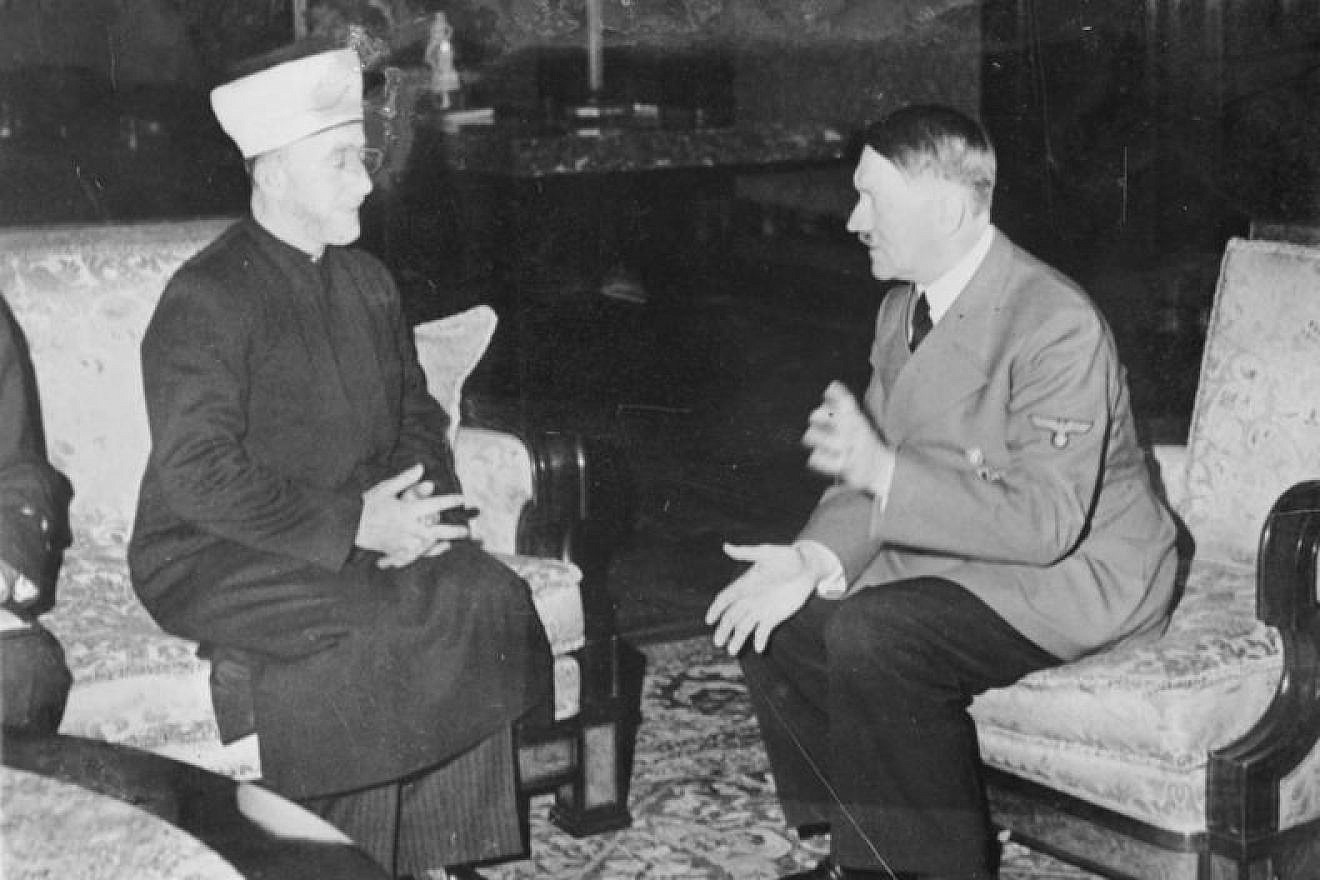In 1921, Herbert Samuel, the British high commissioner of Mandatory Palestine, appointed Haj Amin al-Husseini grand mufti of Jerusalem. It would prove to be a mistake. Husseini would spend his career fomenting violence against the Jews of Palestine and promulgating a reading of the Koran that was genocidally antisemitic.
Husseini became the undisputed leader of the Palestinian national movement and his main ally would be Nazi Germany. The after-effects of that alliance continue to this day.
Husseini spent the 1920s forming a militant network based on Islamism and Arab nationalism. Along the way, he became an admirer of Hitler. After Husseini launched the 1936 Arab revolt in Palestine, the British had enough and stripped him of his position. He then fled to Lebanon and later Iraq. In Baghdad, he started a pro-Axis revolt and a pogrom against the Jews.
In Jan. 1941, Husseini wrote his first letter to Hitler. Husseini claimed that British imperialism was “pitting” Arab countries “against the Jews of the entire world.” He proposed an alliance that would defeat the Zionists and end their support for Great Britain. Together, he said, the Arabs and Germans would solve “the question of Palestine.”
Later that year, Husseini travelled to Berlin and met with Hitler, seeking German help in exterminating the Jews of the Arab world. Hitler agreed and, on that basis, they formed an alliance.
Husseini then became the leading purveyor of Nazi propaganda to the Arab world. As historian Jeffrey Herf documented in his book Nazi Propaganda for the Arab World, this included millions of leaflets and thousands of hours of radio broadcasts. The central theme of these efforts is captured in Husseini’s repeated exhortations to “kill the Jews wherever you find them.”
At the same time, Husseini aggressively silenced moderate Arabs, often by having them assassinated. (His successor, Yasser Arafat, would adopt the same practice.) In this way, he ensured that there could be no compromise with the Zionists.
The Nazis also financed, armed and collaborated with the violently antisemitic Muslim Brotherhood, which continued to admire the Nazis after World War II. In 1946, the Brotherhood’s founder Hassan al-Banna lauded Husseini as a “hero who challenged an empire and fought Zionism with the help of Hitler and Germany. Germany and Hitler are gone, but Amin al-Husseini will continue the struggle.”
Husseini did just that, his reputation burnished by his Nazi collaboration. According to historian Bernard Lewis, pro-German sentiment was so strong in the Arab world “that even after the final defeat of the Third Reich it did not fade away and—what is perhaps more significant—it was not concealed. On the contrary, a pro-Nazi past was a source of pride, not shame.”
That pride was still alive in 2015, when the grand mufti of Jerusalem laid a wreath at Husseini’s grave. In 2019, Mahmoud al-Habbash, a former Hamas official who was appointed by Palestinian Authority chief Mahmoud Abbas as an advisor on religious affairs, marked the anniversary of Husseini’s death by praising him as a “great Palestinian national leader” and a “role model.” Now, nearly half a century after his death, the P.A. preserves Husseini’s memory for the next generation at the “Amin Al-Husseini Elementary School” in El Bireh.
In their seminal book Nazis, Islamists and the Making of the Modern Middle East, Barry Rubin and Wolfgang G. Schwanitz noted, “While the Nazi ideology collapsed in 1945 and virtually vanished from German and European life, the radical Arab nationalist and Islamist ideologies flourished thereafter.”
This was the legacy of the Nazi-Arab alliance. Thus, wrote Rubin and Schwanitz, “the profoundly doctrinal hatred for Jews and the belief in the necessity of destroying them remained the core reason for the Arab-Israeli conflict’s enduring and irresolvable nature.”
As Rubin and Schwanitz documented, Husseini ensured that Axis-style ideology would continue within the Palestinian movement by making Yasser Arafat his successor in 1968: “The movement would be directed by these two sequential leaders and their similar philosophy and methods for an astounding 83 years, from al-Husseini’s becoming grand mufti in 1921 to Arafat’s death in 2004.”
Under Arafat, the Nazis served as an inspiration for Palestinian terrorists. As Rubin wrote in a study of the PLO, more than 25 activists “chose a nom de guerre such as Hitler or Abu Hitler.” These included Fawzi Salim Ali Mahdi, who served in Force-17, a terrorist group “under Arafat’s direct command.” Ian Michael Davison, another notable Force-17 member, was a British neo-Nazi. In 1985, he helped murder three Israelis while attacking a yacht in Cyprus. The PLO group al-Fatah trained German neo-Nazi groups in Lebanon.
Having moved to Palestine after the Oslo Accords, Arafat took control of the content of Friday sermons at the al-Aqsa mosque, making them a tool of incitement. As Efraim Karsh wrote, the sermons became particularly extreme after the beginning of the second intifada in 2000. For example, in one such sermon the preacher instructed his listeners, “Have no mercy on the Jews, no matter where they are, in any country. Fight them wherever you are. Wherever you meet them, kill them.” The echoes of Husseini’s wartime exhortations were unmistakable.
Rubin and Schwanitz stated, “Organizational links to the Axis-era past continue to the present day. The West Bank is ruled by the Fatah-dominated Palestinian Authority, created by Arafat, al-Husseini’s heir and a former Muslim Brotherhood activist.” Gaza is ruled by Hamas, an uncompromising and deeply antisemitic branch of the Muslim Brotherhood “whose worldview is indistinguishable from that of al-Husseini and the Brotherhood in the 1930s and 1940s.” Thus, the radical forces encouraged and funded by the Nazis continue to dominate Palestinian politics.
Even Abbas, a supposed non-violent moderate, has adopted Nazi-inspired propaganda. For example, in his doctoral dissertation, he repeated the Nazi claim that a Jewish “declaration of war” on Germany caused the Holocaust. In a 1983 book based on his dissertation, Abbas claimed that Zionists colluded with the Nazis to promote immigration to Palestine. In 2018, Abbas suggested that Jews brought the Holocaust upon themselves with their “social function,” including “usury and banking and such.” Last year in Berlin, he accused Israel of inflicting “50 Holocausts” on the Palestinians. Thus, much to the embarrassment of his host, Chancellor Olaf Scholz, Abbas engaged in the kind of Holocaust inversion popular on the German far-right.
It wasn’t always this way. As Lewis wrote, “European antisemitism, in both its theological and racist versions, was essentially alien to Islamic traditions, culture and modes of thought. But to an astonishing degree the ideas, the literature, even the crudest inventions of the Nazis and their predecessors have, so to speak, been internalized and Islamized.”
The legacy of this Nazi-style ideology is what Jeffrey Herf called a “tradition of absolute and uncompromising rejection of Zionism and, later, the State of Israel.” Therefore, Herf wrote, “One precondition for a peaceful end to the Israeli-Palestinian conflict lies in an Arab and Palestinian rejection of the reactionary Islamist political theology that Husseini did so much to create. A frank and well-grounded coming to terms with the history of his collaboration with Nazi Germany should be part of that reckoning.”
Whoever replaces Mahmoud Abbas might want to think about that.

























